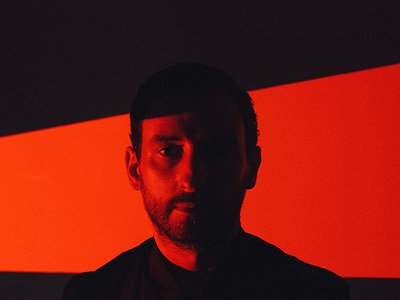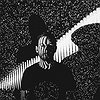Part 1
Name: Max Cooper
Nationality: British
Occupation: Sound Artist, Producer
Current Release: One Hundred Billion Sparks on Mesh
Recommendations: Frank Wilczek – A Beautiful Question, a book looking at if, why and how, nature at the most fundamental level, should be beautiful. This link between aesthetics and the fundamentals of nature are there throughout my visual collaborations, natural systems as explained by science providing a rich source of beautiful content for my live shows and music videos. The other recent book I read recently and enjoyed a lot was Greg Egan’s Permutation City. That’s fiction, but with plenty of meaty science ideas and lots to think about.
Website / Contact: If you enjoyed this interview with Max Cooper, his website and facebook page offer a wealth of information and selections from his work.
What were your main compositional- and production-challenges in the beginning and how have they changed over time?
I was more or less self-taught so the initial challenge was just to try and find something that sounded ok, without having so much control over what I would find. Luckily I had a long history of DJing at that point, so at least I knew what sounded good, and how to structure a track, even if I didn’t know the technicalities of synthesis and production techniques. As long as you can assess every adjustment you make and have a clear idea of what you do and don’t like, that’s all you really need. Along with plenty of time for trial and error. One important thing to remember is that it is difficult to make even simple, good sounds, so not to get too frustrated, and to give yourself the time to experiment. You have to allow yourself to make shit music in order to eventually find something good. I made a lot of shit music and I still do, albeit a little less often now.
In terms of changes to my production challenges from then to now, I can pre-plan my music a lot more, and have much tighter control over my sound-design now. But in the end the same principles are still at the forefront when I make the better tracks – experimentation, playing with new ideas, and trying to express how I feel in an honest manner, musically.
What was your first studio like?
Very basic, just a laptop and studio monitors, I couldn’t afford anything more. I put what resources I had into trying to get decent monitors and to try and treat the room as best I could acoustically with duvets hanging on the walls and makeshift bass traps. I was always paranoid about being able to hear the sound properly as I knew small mistakes can be amplified up to a mess in a club situation. I also tried to restrict myself to a few soft-synths and effects, to try and get the most out of a few things that I liked, rather than getting lost in too many possibilities.
How and for what reasons has your set-up evolved over the years and what are currently some of the most important pieces of gear for you?
I was very digital focused for many years because hardware was too expensive, and that gave me a good grounding in digital techniques and unusual audio processing which has been very useful as I’ve slowly transitioned more into the hardware/analogue realm. I’m a fan of both approaches, good music isn’t defined by the digital/analogue division at all, but I find hardware in general more productive to interact with. It’s easier to get an intuitive understanding which aids expression, with something physical. It’s that humanised/expressive link which for me, is much more important than whether the oscillator is digital or analogue. If anything, I find the biggest difference in terms of hardware/software created timbre, in effects pedals vs software effects. So now I don’t bother trying to emulate grittiness with software, and I focus my software work onto techniques for which there isn’t good hardware alternatives – granular synthesis, FFT based effects, complex modulating systems and that sort of thing.
My most important pieces of gear are my Prophet 6, Prophet 8, Moog Sub37, Moog Minitaur, Juno 6, Geiger Counter, Big Sky, Fairfield Circuitry Meet Maude and Shallow Water, Moogerfooger Midi Murf, Roland Space Echo, Memory Man delay, Industrialectric RM1N and Echo Degrader, Ableton, Max for Live, Soundtoys, and many other plugins.
In terms of the feedback mechanism between technology and creativity, what do humans excel at, what do machines excel at?
Machines excel at the countless boring tiny jobs which are too long and repetitive for us to do, and we excel at seeing the bigger picture which the machines, cannot, yet, see.
Production tools, from instruments to complex software environments, contribute to the compositional process. How does this manifest itself in your work?
I’m very much constrained and lead by the tools I use. I’m always looking for ways to make them break or perform some operation or synthesis which they weren’t designed for, so that I can find something a little different. But I’m still constrained with small boundaries. I’d love to escape this constraint, and I’ve started working with software developers on new tools to facilitate forms of expression I could not otherwise access, but this is a long path, something for the future I hope. On the other hand, people like Rob Clouth are doing it already, writing their own software tools which yield music in their own exclusive way. I’d love to get to that point. But for now, I rely on my own particular combination of hardware and software techniques that is so obscure it almost certainly must be unique to me.
Can you describe the co-authorship between yourself and your tools?
My sound is defined by my tools, there is no escaping that. But that’s true of any music, or any art for that matter. When I’m using generative approaches the machines take on a little more authorship too. For example when I set up a sound generating system whose behaviour is only partially under my control, with a healthy dose of randomisation going on in order to explore within the box of possibilities I’ve set. In those cases it’s all about finding the right box.
Collaborations can take on many forms. What role do they play in your approach and what are your preferred ways of engaging with other creatives through, for example, file sharing, jamming or just talking about ideas?
For the visual side of my work the process is through lots of talking. I create visual themes for each piece of music from the start of the creation process, and then after the music is made (sometimes before), I chat to visual artists about the ideas which they then interpret in their own way for the music videos. Whereas for musical collabs I prefer the live jamming route.






